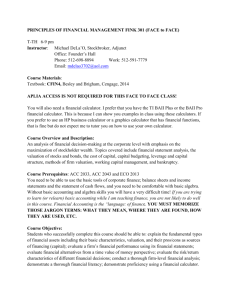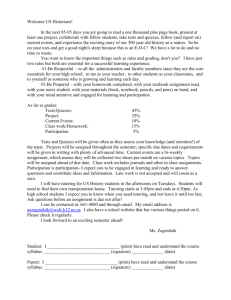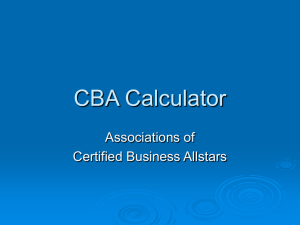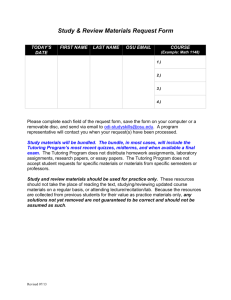FINK 301-120 Prin of Fin Mgmt - Texas A&M University
advertisement
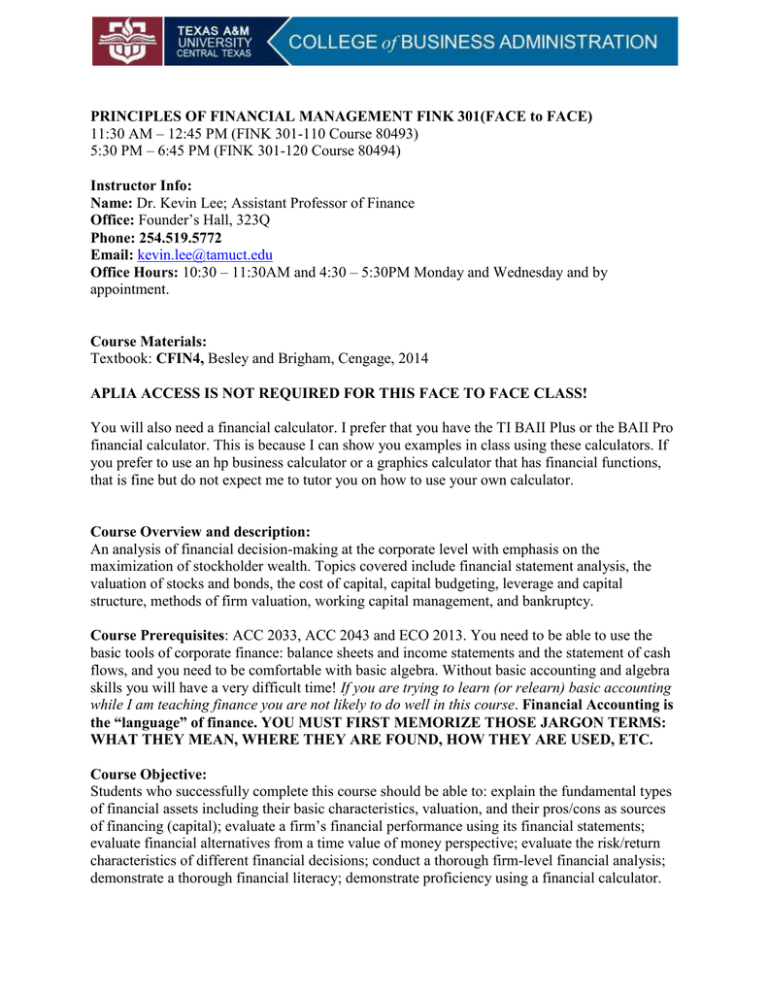
PRINCIPLES OF FINANCIAL MANAGEMENT FINK 301(FACE to FACE) 11:30 AM – 12:45 PM (FINK 301-110 Course 80493) 5:30 PM – 6:45 PM (FINK 301-120 Course 80494) Instructor Info: Name: Dr. Kevin Lee; Assistant Professor of Finance Office: Founder’s Hall, 323Q Phone: 254.519.5772 Email: kevin.lee@tamuct.edu Office Hours: 10:30 – 11:30AM and 4:30 – 5:30PM Monday and Wednesday and by appointment. Course Materials: Textbook: CFIN4, Besley and Brigham, Cengage, 2014 APLIA ACCESS IS NOT REQUIRED FOR THIS FACE TO FACE CLASS! You will also need a financial calculator. I prefer that you have the TI BAII Plus or the BAII Pro financial calculator. This is because I can show you examples in class using these calculators. If you prefer to use an hp business calculator or a graphics calculator that has financial functions, that is fine but do not expect me to tutor you on how to use your own calculator. Course Overview and description: An analysis of financial decision-making at the corporate level with emphasis on the maximization of stockholder wealth. Topics covered include financial statement analysis, the valuation of stocks and bonds, the cost of capital, capital budgeting, leverage and capital structure, methods of firm valuation, working capital management, and bankruptcy. Course Prerequisites: ACC 2033, ACC 2043 and ECO 2013. You need to be able to use the basic tools of corporate finance: balance sheets and income statements and the statement of cash flows, and you need to be comfortable with basic algebra. Without basic accounting and algebra skills you will have a very difficult time! If you are trying to learn (or relearn) basic accounting while I am teaching finance you are not likely to do well in this course. Financial Accounting is the “language” of finance. YOU MUST FIRST MEMORIZE THOSE JARGON TERMS: WHAT THEY MEAN, WHERE THEY ARE FOUND, HOW THEY ARE USED, ETC. Course Objective: Students who successfully complete this course should be able to: explain the fundamental types of financial assets including their basic characteristics, valuation, and their pros/cons as sources of financing (capital); evaluate a firm’s financial performance using its financial statements; evaluate financial alternatives from a time value of money perspective; evaluate the risk/return characteristics of different financial decisions; conduct a thorough firm-level financial analysis; demonstrate a thorough financial literacy; demonstrate proficiency using a financial calculator. Student Learning Outcomes by chapter: 1. AN OVERVIEW OF MANAGERIAL FINANCE Discuss the basic types of financial management decisions and the role of the financial manager. Identify the goal of financial management. Compare the financial implications of the different forms of business organizations. Describe the conflicts of interest that can arise between managers and owners. Discuss the role of ethics and corporate governance in a well-functioning economic system. 2. ANALYSIS OF FINANCIAL STATEMENTS Interpret the information provided in a firm’s basic financial statements. Standardize financial statements for comparison purchases. Compute and interpret common financial ratios. Assess the determinants of a firm’s financial performance. Identify and explain some of the problems and pitfalls in financial statement analysis. 3. THE FINANCIAL ENVIRONMENT Describe the role the financial markets play in determining living standards and economic growth. Distinguish between the various types of financial markets. Describe the various types of financial intermediaries and their functions. 4. THE TIME VALUE OF MONEY (TVM) Determine the future value of an investment made today. Determine the present value of cash to be received in the future. Calculate the rate of return on an investment. Given any 4 of the TVM variables (n, k, pv, pmt, fv) be able to calculate the unknown variable. Determine the future and present value of investments with multiple cash flows. Describe the loan amortization process and create a loan amortization table. Explain how interest rates are quoted. 5. THE COST OF MONEY (INTEREST RATES) Describe the cost of money and the factors that influence interest rates. Describe how interest rates are determined. Describe the yield curve and discuss how to interpret the markets expectations of future interest rates based on the shape of the yield curve. Discuss the impact on changes in interest rates (required rates of return) affect the value of financial assets. 6. BONDS (DEBT) Identify important bond features and types of bonds. Describe how bond are valued and why bond values fluctuate. Discuss bond ratings and what they mean. Evaluate the impact of inflation on interest rates and bond values. Explain the bond structure of interest rates and the determinants of bond yields. 7. STOCKS (EQUITY) Assess how stock prices depend on future dividends and dividend growth. Identify the rights and privileges of stockholders. Explain how stock markets work. 8. RISK AND RATES OF RETURN Explain the basic concept of risk in finance. Calculate the rate of return on an investment Distinguish between diversifiable and non-diversifiable risk and how diversifiable risk can be eliminated Describe the components of an asset’s risk premium Identify different types of risk 9. CAPITAL BUDGETING TECHNIQUES (NPV & IRR) Describe the general nature and process of capital budgeting Calculate a projects NPV and justify a go/no go decision Calculate a project’s IRR and justify a go/no go decision Explain ranking conflicts and the conditions under which they are likely to occur. 11. COST OF CAPITAL Calculate the component cost of capital for debt, preferred stock, retained earnings, and new common equity Describe the weighted average cost of capital (WACC) Discuss the relationship between WACC and investors’ required rates of return 12. CAPITAL STRUCTURE Discuss the effects of financial leverage Analyze the determinants of a firm’s optimal capital structure. Discuss the essentials of the bankruptcy process. 13. DISTRIBUTION OF RETAINED EARNINGS Discuss dividend policy decisions Describe stock dividends and stock splits Describe stock repurchases Explain differences in dividend policies around the world Competency Goals: • Understand the agency relationship, recognize agency violations, and correct unethical corporate behavior. • Read real-world financial statements and draw accurate conclusions about the firm's financial health. • Construct and interpret important financial ratios. Make informed short- and long-run financing decisions based upon expected movements in interest rates. • Apply risk/ return concepts in assessing the required rate of return for suppliers of debt and equity capital. • Apply time value of money methods to financing and corporate decision-making. • Undertake fundamental valuation of the firm's debt and equity securities using prescribed models. • Compute and utilize the firm's cost of capital in financial decision-making. • Make investment decisions using established capital budgeting techniques. • Understand the different types of risk associated with various forms of leverage. • Understand the implications of a sub-optimal capital structure. • Recognize the real-world factors that impact the capital structure decision. • Understand dividends and share repurchases as they impact firm valuation. • Understand and be able to use the Internet as an important source of financial data and information. • Be financial calculator literate. Course Requirements: Homework (300 points) – There will be end of chapter homework assignments throughout the semester. All homework assignments combined will be worth 300 points. I will not accept late homework. Let me repeat. I WILL NOT ACCEPT LATE HOMEWORK! (Unless there are some extenuating circumstances but that will be a case by case determination) Quizzes (100 points) – I will give out at least 10 pop quizzes throughout the semester. Each quiz is worth 10 points and the total number of points you can earn from quizzes is 100 points. This means if I give out 12 quizzes and you miss two of them, you can still get full points for quizzes. However I will not give more than 100 points total, no matter how many quizzes you have taken. Exams (600 points) – You will have 3 exams in this class. Each exam is worth 200 points. All exams will cover material from the chapters that were covered after the previous exam. This means that the exams are not comprehensive…technically. However, since much of the material builds on itself, you must understand earlier chapters to be able to show your understanding of later chapters. Grading: 900+ 800 – 899.99 700 – 799.99 600 – 699.99 0 – 599.99 A B C D F NOTE: Requests for Incomplete Grades: Incompletes will only be given in emergency or other extreme circumstances. Any request for an incomplete grade in this course must be approved by the professor prior to the last week of classes. Requests should be submitted in written form, include a detailed explanation and documentation, and must include an address and/or telephone number where you may be contacted throughout the following semester. There is a university requirement that a substantial portion of the course work must have been completed by the student prior to receiving and incomplete. Also, students will be required to enter into a contract with the professor to finish the course within some set timeframe to be determined by the professor. Students will no longer be able to get an IC after doing 5% of the class and then get an extra semester to complete their work. ACADEMIC SUPPORT, RESOURCES AND POLICIES UNILERT is an emergency notification service that gives Texas A&M University-Central Texas the ability to communicate health and safety emergency information quickly via email, text message, and social media. All students are automatically enrolled in UNILERT through their myCT email account. Connect at www.TAMUCT.edu/UNILERT to change where you receive your alerts or to opt out. By staying enrolled in UNILERT, university officials can quickly pass on safety-related information, regardless of your location. Drop Policy It is the student’s responsibility to be aware of University mandated drop deadlines should you find yourself needing to drop this course. The deadlines are all available via the “TAMUCT Academic Calendar” link from the Course web site left-hand menu. If you discover that you need to drop this class, you must contact the Records Office and ask for the necessary paperwork. Professors cannot drop students; this is always the responsibility of the student. The record’s office will give a deadline for which the form must be returned, completed, and signed. Once you return the signed form to the records office and wait 24 hours, you must go into Duck Trax and confirm that you are no longer enrolled. If you are still enrolled, FOLLOW-UP with the records office immediately. Should you miss the deadline or fail to follow the procedure, you will receive an F in the course. Incompletes are not given except for documented medical or family emergencies, with a significant portion of the course already completed. Academic Integrity Texas A&M University - Central Texas expects all students to maintain high standards of honor in personal and scholarly conduct. Any deviation from this expectation may result in a minimum of a failing grade for the assignment and potentially a failing grade for the course. All academic dishonesty concerns will be reported to the university's Office of Student Conduct. Academic dishonesty includes, but is not limited to, cheating on an examination or other academic work, plagiarism and improper citation of sources, using another student's work, collusion, and the abuse of resource materials. When in doubt on collaboration, citation, or any issue, please contact me before taking a course of action. More information can be found at http://www.tamuct.edu/departments/studentconduct/academicintegrity.php Disability Support Services If you have or believe you have a disability and wish to self-identify, you can do so by providing documentation to the Disability Support Coordinator. Students are encouraged to seek information about accommodations to help assure success in their courses. Please call (254) 5015831 or visit Founder's Hall 114, Suite 114. Additional information can be found at http://www.tamuct.edu/departments/disabilitysupport/index.php Tutoring Tutoring is available to all TAMUCT students, both on-campus and online. Subjects tutored include Accounting, Finance, Statistics, Mathematics, and Writing. Tutors are available at the Tutoring Center in Warrior Hall, Room 111. Visit www.ct.tamus.edu/AcademicSupport and click "Tutoring Support" for tutor schedules and contact info. If you have questions, need to schedule a tutoring session, or if you're interested in becoming a tutor, contact Academic Support Programs at 254-501-5830 or by emailing tutoring@ct.tamus.edu. Chat live with a tutor 24/7 for almost any subject on your computer! Tutor.com is an online tutoring platform that enables TAMUCT students to log-in and receive FREE online tutoring and writing support. This tool provides tutoring in Mathematics, Writing, Career Writing, Chemistry, Physics, Biology, Spanish, Calculus, and Statistics. To access Tutor.com, log into your Blackboard account and click "Online Tutoring." Course Calendar: This calendar is tentative and may change throughout the semester at the discretion of the professor. Date 8/25 M Topic Financial Management – Introduction and Organization An Overview of Managerial Finance Labor Day Analysis of Financial Statements Analysis of Financial Statements The Financial Environment: The Financial Environment: Time Value of Money Ch. Assignment Due 1 1,3,4,6,9-13,15 No class 1,2, 5-19 odd problems 9/22 M 9/24 W 9/29 M 10/1 W 10/6 M 10/8 W 10/13 M 10/15 W 10/20 M 10/22 W 10/27 M 10/29 W 11/3 M 11/5 W 11/10 M 11/12 W 11/17 M 11/19 W 11/24 M 11/26 W 12/1 M 12/3 W Time Value of Money Review Exam 1 The Cost of Money The Cost of Money Bonds Characteristics and Valuation Bonds Characteristics and Valuation Stocks Characteristics and Valuation Stocks Characteristics and Valuation Risk and Rates of Return Risk and Rates of Return Review Exam 2 Capital Budgeting Techniques Capital Budgeting Techniques The Cost of Capital The Cost of Capital Capital Structure Capital Structure Distribution of Retained Earnings: Distribution of Retained Earnings: Review 4 12/8 M 12/10 W Exam 3 Final Exam 8/27 9/1 9/3 9/8 9/10 9/15 9/17 W M W M W M W 2 2 3 3 4 2,3,5,9,10-20 even problems 1,2,4-7,10,11-25 odd problems Homework for chap 1-4 due 5 5 6 6 7 7 8 8 Homework for chap 5-8 due 9 9 11 11 12 12 13 13 Homework for chap 9, 11-13 due (Optional)
